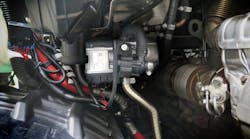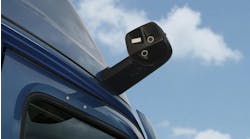An auxiliary coolant heater can help a fleet reduce idle time and fuel consumption, resulting in several benefits to a diesel truck’s engine and aftertreatment system.
“On average, an idling Class 8 truck will burn about 1 gallon of fuel per hour,” said Dan Erck, regional sales manager at Webasto, a producer of idle-reduction technologies including engine-off heating and cooling systems. “A Webasto Thermo Top Evo, for example, can run for 10 hours on a single gallon of fuel. Considering that you only need to operate the coolant heater for 30 to 40 minutes prior to engine startup depending on ambient temperature, this could save a fleet thousands of dollars in fuel costs alone.”
Since the engine does not have to run so long to warm up, there is also an emissions advantage to be gained — even in environments that are not that cold. The amount of particulate matter a diesel particulate filter (DPF) has to trap is reduced. Then, because an auxiliary coolant heater helps an engine reach optimum operating temperature faster and more efficiently, it is faster and more efficient for exhaust gases to also reach the necessary temperature to perform a DPF regen.
“The frequency of diesel regens can also be greatly reduced — regens that would otherwise be required due to plugged particulate filters,” added George Lenus, manager of training and national accounts support at Eberspaecher, a manufacturer of climate control systems, idle-reduction technologies, exhaust systems, and other products. “Fleets can also see a reduction in the constant need to clean or change out DPF filters.”
A coolant heater is typically mounted in the engine compartment to be integrated into the truck’s coolant system. It draws coolant into a heat exchanger where it is warmed up and pumped back to the engine. The result is an engine that is preheated before it is started. Warm engine oil allows for improved circulation upon engine startup, helping protect sensitive components while reducing strain on the starter and cranking time on the battery. Fuel injectors are also warmed, allowing fuel to be moved into the system more easily. This further helps reduce fuel consumption, emissions, and DPF-related issues.
“The typical operating range of a truck is 150 to 180 degrees Fahrenheit,” Webasto’s Erck said. “Even in a place like Texas during the summer, it is not warm enough to prevent cold-starts. Preheating with a coolant heater helps get that vehicle up to operating temperature to reduce emissions. In fact, preheating the engine will reduce particulate matter during startup by 66%, NOx by 40%, and CO by 62% based on ambient temperature. That will reduce the need for DPF cleaning and/or replacement.”
Both Webasto and Eberspaecher coolant heaters are compatible with all industry-standard coolant types as recommended by the OEs.
Other preventive maintenance measures are also relatively straightforward.
“Run the heater once a month, even during the summer, for at least 20 minutes,” Erck recommended. “This helps ensure that fresh fuel is running through the system all year long. Then, just replace the fuel filter annually.”
Eberspaecher’s Lenus said technicians should inspect the heater annually, looking for any signs of damage or faulty installation.
“It is also recommended to do a diagnostic test of the heater at least once a year, preferably prior to the heating season, to review operational data and clear fault codes stored in the heater’s memory,” Lenus said.
This article originally appeared on FleetMaintenance.com.



